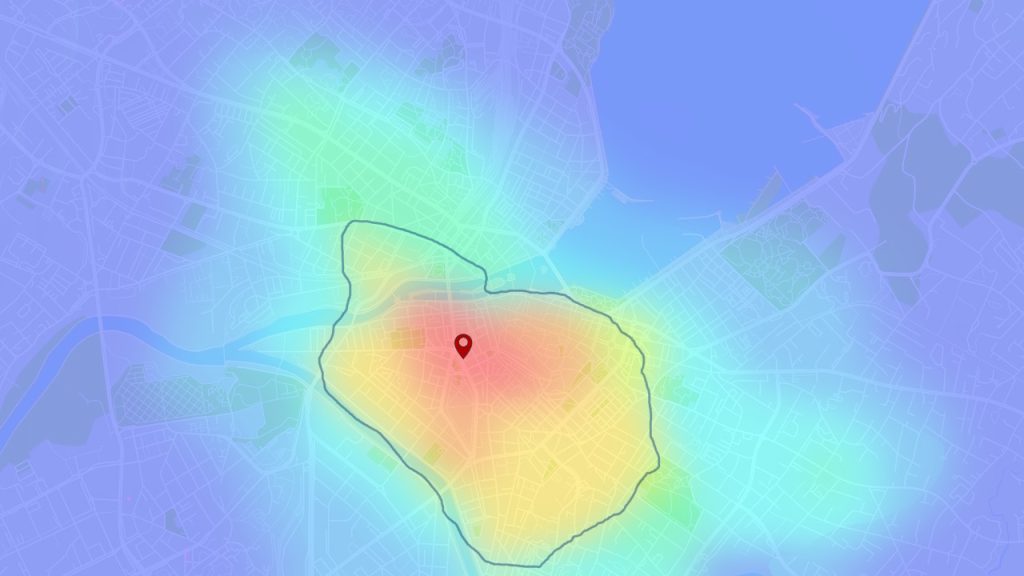
This post was originally published in 2019 and has been updated for 2025 with more insights and actionable strategies.
Expanding your retail or franchise chain? Choosing the right site starts with defining an effective trade area. Whether you’re selecting your first location or your 20th, understanding where your customers are coming from helps you make smarter, faster, and more confident decisions.
In 2025, retail site selection is more complex than ever, but also more precise. Thanks to better tools and better data, retailers no longer have to rely on gut instinct. With access to retail foot traffic data, demographic insights, and powerful modeling platforms, you can define trade areas that reflect actual customer behavior, not just assumptions.
What is a Trade Area?
There are many different ways to delineate a trade area, but first, let’s define the term.
A trade area is the geographic region from which a business draws the majority of its customers.
The size, shape, and boundaries of that trade area vary depending on several factors that influence how far people are willing to travel (and why), like:
- The type of product or service you offer – Convenience items such as groceries and gasoline draw from a smaller trade area than a furniture store, which might pull customers from across a region.
- Competitors in the area (new and existing) – The presence of new or existing competitors nearby can shrink, expand, or redirect a trade area—especially in saturated markets.
- Market saturation – The availability of goods and services offered in the community impacts a business’s draw.
- Proximity of the store/business to other similar stores/businesses – Clustering with complementary stores can either help or hurt, depending on the context. Being too close to a direct competitor could dilute your market.
- Physical barriers – Rivers, lakes, railway tracks, large parks, and forests can discourage people from visiting a store, even if they are nearby.
- Psychological barriers – Perceived neighborhood barriers, safety concerns, and income divides can reduce people’s willingness to visit certain areas, even if they are physically convenient and close.
Understanding these factors is critical to building a trade area that reflects reality. With modern retail trade area analysis and retail foot traffic data, you can map customer behavior more accurately and define smarter trade areas that lead to better decisions.
Five Common Types of Trade Areas

There are several common methods used to define trade areas, each with its own strengths:
Radial rings
A ring is exactly what it sounds like: a circle around a site to represent its trade area. Radial rings are a simple and fast way to estimate market reach and compare one market to another (as a 3-mile ring in both, for example). The downside: this type of trade area doesn’t accurately represent consumer’s actual travel patterns or account for real-world traffic, geography, or accessibility.
Drive time polygons or isochrones
These models define trade areas based on how far a customer can drive in a specific amount of time, like five minutes or 15 minutes, relying on assumptions about average driving speeds and traffic conditions. A drive time trade area forms an irregular shape based on road types, congestion, traffic, and speed limits. Although it reflects realistic customer behavior better than a radial ring trade area, it can be difficult to visualize and explain.
Gravity or Huff model
A gravity technique examines the demand in a market and allocates that demand to different locations based on distance and appeal. This probabilistic model estimates the likelihood that a consumer will choose one location over another. The Huff model is helpful when comparing a site and other competing options near it, helping retailers understand which areas are most likely to convert into visits. That said, it is a probabilistic model, not a geographic one, so it doesn’t offer a fixed boundary. It also is only useful when comparing competing locations (as in a competitive market analysis or a cannibalization study).
Customer penetration or capture rate
In this method, a trade area captures a set percentage of a business’s customer base (e.g. 75%). Because this approach is based on actual customer data, it offers an accurate picture of a retailer’s actual reach. On the flip side, it requires that the retailer has first-party customer data or third-party data (e.g. consumer mobile phone activity). That makes it a less practical method for evaluating new sites (but more appropriate for analyzing existing locations).
Manual trade area
Lastly, many companies choose to define trade areas using their local knowledge and insights, municipal boundaries, and even franchise territories. Although this can work well when layered with demographic and competitive data, it is less objective than other trade area delineation methods. A company might draw a trade area that is based more on wishful thinking than data, which might not produce an accurate representation of consumer travel patterns.
Understanding Primary, Secondary, and Tertiary Trade Areas
When determining your trade area for a location, it’s helpful to think in terms of “tiers” of reach, starting with your core customers and working outward from there.
A primary trade area is the geographic area from which you will draw the majority of your customers (think 50-80% or more). This is your primary revenue generating area, and for most retailers, this area is where it’s critical to understand demographics, competition, and site performance.
The secondary trade area represents a larger geographic area from which you draw customers and accounts for 15-30% of your customer base. These customers might visit less often and come from a further distance, but they are still important when evaluating expansion potential, leakage, and more.
Lastly, the tertiary trade area accounts for additional customers. Although this is a much smaller share typically (usually less than 10%), for certain businesses like destination retail concepts and tourist-oriented businesses, the tertiary trade area can be significant. In major metropolitan areas, it can be surprisingly large.
Modern Retail Trade Area Analysis
Determining your trade area is a critical step in the site selection process. Today, advanced retail trade area analysis blends mobility data, demographic trends, competition mapping, and site-specific characteristics into one cohesive view. This approach helps you answer essential questions, like:
- Where is my customer base coming from?
- How does that differ by time of day or day of week?
- How far are customers willing to travel for my service or product offering?
- What neighborhoods are untapped?
Why is that important? So you can understand not just who your customers are, but also how they behave.
Applying Trade Area Insights to Franchise Territory Design

SiteSeer has continued to adapt its platform to meet the needs of today’s retail planners, real estate developers, and franchise developers. One of the most valuable features is the Automated Territory Optimization Model (ATOM).
While trade areas focus on where a specific store draws its customers from, territory optimization takes a broader view. It’s about designing balanced, fair market areas that support franchise systems’ long-term growth while avoiding overlap and competition between franchisees.
ATOM helps users create balanced territories using the same data that informs trade area design: foot traffic, demographics, drive times, competition, and customer behavior. When paired with SiteSeer Professional, teams can visualize different scenarios, incorporate local or franchisee feedback, and compare configurations side-by-side.
Today’s Retail Site Selection is Precise and Localized
What sets successful retailers apart is their ability to make site decisions that reflect the realities of each market where they operate. They rely on accurate data to model trade areas that align with how customers live, travel, and shop.
Good news: You don’t need a big team or budget to do the same type of analysis.
SiteSeer is built specifically to empower small and mid-sized retail chains to step up their retail analytics and gain the same level of insight as larger national brands. It’s powerful enough to scale with growing retail chains, but affordable and easy to use for those early in their growth journey too.
Make Informed, Strategic Decisions to Support Your Growth
Ready to grow smarter? SiteSeer helps you determine where your customers come from, how they reach you, and where your next location should be. Make data-driven site decisions that match your growth strategy. Request a demo today.


